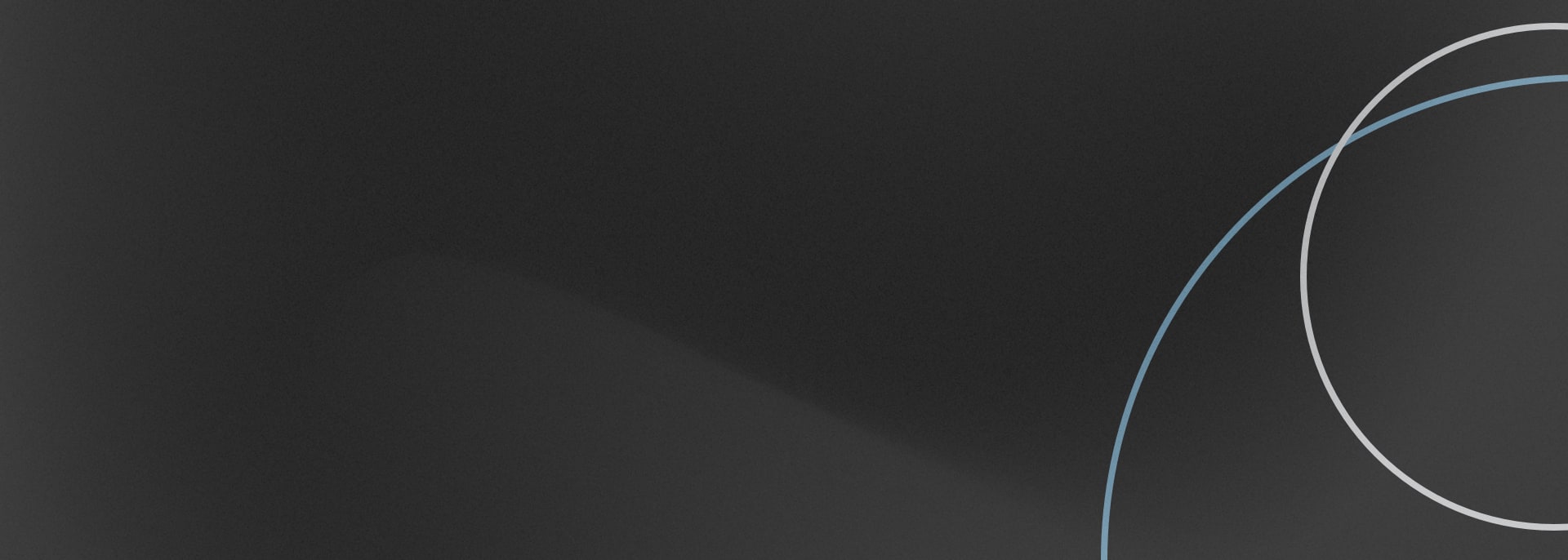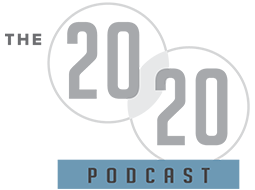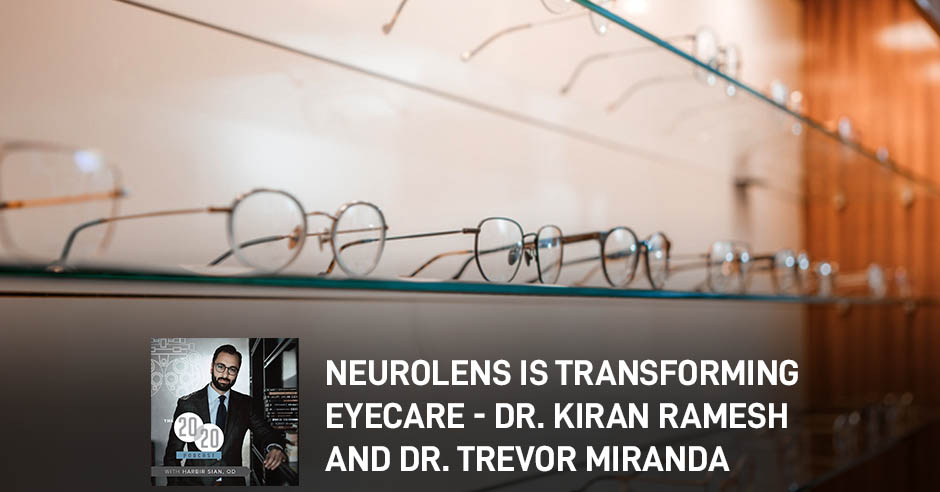
What do TMJ, motion sickness, headaches, and eye strain all have in common? ONE, they can be caused by tiny misalignments in your eyes. And TWO, they can all potentially be resolved by measuring the misalignment in a Neurolens device and prescribing their patented contoured prism technology. In this episode, two seasoned practitioners, Dr. Kiran Ramesh and Dr. Trevor Miranda, share how Neurolens has changed their already busy practices.
Learn more at Neurolens.com
Don’t forget to SUBSCRIBE, RATE, and COMMENT
—
Watch the episode here
Listen to the podcast here
Neurolens Is TRANSFORMING Eyecare – Dr. Kiran Ramesh And Dr. Trevor Miranda
If you tune in to the show for a while, you may recognize these two beautiful people next to me here. I have the amazing Dr. Trevor Miranda and the wonderful Dr. Kiran Ramesh with me. We are going to be talking about a very specific technology, and that is, and maybe more specifically, more excitingly, their brand-new device called the N3, this headset, which is a brand-new version of the Neurolens. Thank you both for being here. We are in Las Vegas at Vision Expo West, outside the Neurolens’ booth.
It’s been an amazing experience. I’ve been here for a couple of days, and as always, Vision Expo does not disappoint. It’s always amazing to connect with wonderful people, learn new things, and look into the new amazing technologies that are emerging and coming out to support us in our practices. Dr. Trevor Miranda and Dr. Kiran Ramesh, thank you very much for being here.
Thanks for having us.
Trev, give us a little intro if you wouldn’t mind. I know people know who you are, but tell us who you are. Kiran, if you wouldn’t mind taking it after.
I’m Trevor Miranda. I practice on Vancouver Island. I have five cold start practices. We have the NMD2, which is the previous version of Neurolens. We’re excited to have the N3. Thanks for having me.
Always a pleasure.
I’m Dr. Kiran Ramesh, and I practice in Ontario. Like Trevor, I have the NMD2 and am very excited about the N3. Again, thank you for having me and us. We love collaborating.
I love you guys, so it’s always a pleasure to have you on. Let’s talk a little bit about Neurolens. You both had it for a long time or at least a while in your practices. I’d like to know, with as much detail as you like, how having Neurolens the NMD2, which is that physical tabletop device, impacted your practice.
I can help patients with complaints that I didn’t think it was their eyes. I didn’t think I had a solution for them, and I do with the Neurolens now and symptoms such as neck pain, jaw pain, and phantom dry eye, what I call a mismatch between the signs and symptoms of dry eye. In the past, “It’s not your eyes. It must be something else. Go see your family doctor,” but now I’m helping these patients. The feedback is amazing. I phone each of my patients who purchase Neurolens from us, back myself, and get direct feedback from the patients. It’s amazing and builds our confidence to recommend it to other patients who have similar complaints.
It’s been a bit of a game changer, and as you said, you’re helping people that you were never able to help before. For me, we’ve been calling people as well. We call them after 2 days, 2 weeks, or 1 month, and they are so happy with everything that they’re receiving. Honestly, from January 2023 until now, we’ve only had one person who had to take it back. It’s been working very well.
That’s great to hear, considering how many you’ve sold and how many patients you put through, and only one person has had to. You are an expert in VT, and I am not. I’m wondering if I need to. I have a very basic binocular vision type of expertise in my practice. Not something I do much. Do I need to have that base knowledge? Do I need to up my knowledge of binocular vision and vision therapy to adopt something like this? Where does it fit in for somebody like me who doesn’t have that basic knowledge?
Honestly, you don’t need to do anything. It’s for every primary care practitioner. We put it in as part of our primary care practice. It’s part of our pretest. Everyone’s getting it done. It helps screen to make sure you are having any symptoms. If you are, we can help you. You don’t need any VB knowledge or VT knowledge.
Trev, I know you’re an honest and authentic person genuine answer here. What’s your level of BV knowledge? How much do you practice BV? How much do you feel like you need it to bring Neurolens in?
I did not like BV. We have a VT practice, but I’m not a BV at all. It was not an area that I was at a lot of interest in, but it’s cool. The Neurolens measurement device has a dynamic for you. You’re getting vertical and horizontal. It’s how your eyes work together, and that hit home to me. We’re measuring your binocularity and not separating horizontal and vertical deviations.
We’re doing it dynamically with both eyes. The Neurolens piece starts helping me understand what is going on when you fixate on images and change your fixation. Now, I’m a little bit more of an expert. I’m more confident because I can interpret that information from the Neurolens device and help those patients. I’m learning as I go, but I’m helping patients along the way.
You didn’t need any actual knowledge prior to that. It’s simple. The device does everything for you. It does all the measurements. It spits out what you need to prescribe, so if you didn’t know, you’re fine.
I didn’t take two years of courses like you did or more. Kiran is one of the top-level experts in vision therapy. On that note, interesting to me that you are an expert in the area of vision therapy, binocular vision. I would think somebody in that position doesn’t need a Neurolens.
A lot of people think that, but we’re in a world where convenience is the reason behind everyone’s purchases. You can either choose to go through training for so many weeks or get the Neurolens which will help your symptoms right off the bat. With that being said, there are some people that still do need vision training. There are some people that need the Neurolens and vision training. It all works hand in hand. It’s been an asset. It’s helped my vision therapy and also supported it.
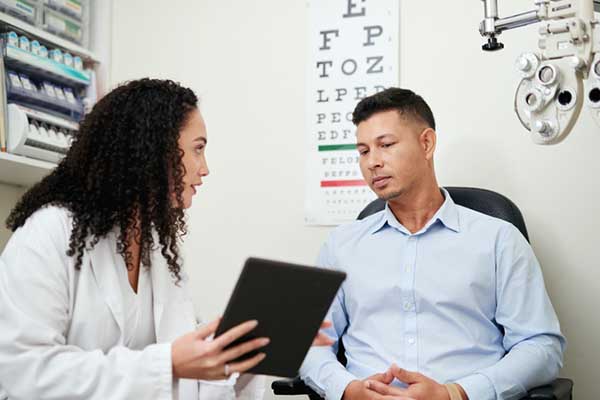
I want to stay on the VT thing for a second. Could you differentiate maybe an example of a patient where Neurolens did work and were fine or a patient who didn’t fit the Neurolens model?
A lot of times, people would come in with concussions. Sometimes, a concussion is so bad that it’s very hard to start training them and getting into exercise. We had one patient who walked in. When she walked into our clinic, she couldn’t even listen to the sound of the radio. She had her sunglasses on. She could barely speak to me.
We put Neurolens on her, and I said, “Let’s start with this. I’ll see you a month later, then we’ll talk about starting with vision therapy.” She came back a month later. She’s a professor. She was speaking, the radio was on, and the sunglasses were off. I was shocked. I didn’t even know what the same person was. That’s where it works well. Have I had anyone where I haven’t made it? Maybe there’s been some children where it’s easier to do the training. It’s a very simple problem, rather than having them in glasses for the rest of your life. I can easily do the vision training. You balance what the person needs.
The other thing I was wondering about is staying on the VT thing. Sorry to exclude you, Trevor. I know you’re itching to talk. On the VT thing, again, being an expert in this space, how did you become comfortable trusting a device? You’re an expert. I imagine you trust your level of expertise more than a machine. You would initially, anyway. What was it that ultimately made you trust the measurements coming out of the machine?
I would check stuff, the measurement, and trial it. I did that for maybe 3 to 4 months. Now, at this point, I don’t check anything. I look at the measurements, and I’m like, “Here’s what you need.” It’s having the feedback and having the patients that were happy, and it was working that I know I can now trust the machine.
You did that. You tested it. You compared it to your own results, and you found it’s consistent, successful, or it’s giving the results in one.
My own results are limited. The Neurolens can measure prism to the point one diopter, and I can only prescribe to the quarter diopter. I can only get a certain measurement, but this was more concise and more accurate.
It’s amazing. You measuring to a quarter diopter is much more specific and accurate than maybe most of us are measuring. Most of us are not measuring to that level. Maybe to this single dial to rounding up in most cases. The fact that you’re going to that level and still finding that contour prism to be beneficial is amazing. Trev, it’s your turn. One of your areas of expertise, Trev, is dry eye. You got all the technology, everything under the sun. Where does this fit? You teased it a little earlier. You might have these masquerading types of patients. How is this going to help somebody who’s in the dry eye space? How does Neurolens relate to dry eye?
We screen all of our dry eye patients in the dry eye clinic on Neurolens because there are a number of patients that would benefit from dryer symptomology with Neurolenses. Now, they might still have overt dry eye, and you might have to still treat them with dry eye, but there’s a number of patients that I’ve treated them just with Neurolens.
Those patients especially have any signs of dry eye but complain of dry eye light symptoms. Those are amazing cases because they may have tried and dabbled in dry eye treatments, and nothing’s worked. You can almost take away their dry symptoms with Neurolens in some cases. We know that the trigeminal nerve innervates at the cornea and can cause these phantom dry eye symptoms.
Can you give me an example of what some of those dry-eye-like symptoms are? What are the complaints that patients are giving?
Those patients that I found that benefit from Neurolens that are dry eye patients. Their complaint is very high. They’re like, “My eyes are dry all the time.”
It’s one of those like, “Sorry to interrupt,” that pain without staying type.
It’s almost like a neurotrophic pain. Some of those neurotrophic cases are disparity cases. They have an exophoria that could have been helped with Neurolens. If you have a dry eye clinic, if you specialize in dry eye, a mandatory piece of equipment, like my biography, is Neurolens. You should be testing all those bases for Neurolens. Anecdotally speaking, I’m not a scientist]. My patient in my chair is my scientific case. I’ve had a lot of patients whom I’ve treated with Neurolens, and it’s helped their symptoms. It’s amazing. I phone them back myself, and it’s helped.
Do you call your patients yourself?
I call my patients that have Neurolens.
Do you have anything to add on the dry-eye side of things, Kiran?
To his point, I had a patient come in, and he has been treated for dry eye for months. He’s going on and on with the symptoms. He even changed his entire diet. I put him in the Neurolens, and I didn’t call him back. I have people.
She has people.
They called them back, and he went and bought a second mirror. He was so happy, and he didn’t have to do any dry eye treatments after that.
If I could add to that point, a lot of patience buys multiple pairs with Neurolens. They’re so happy and they’ve never felt as good. That makes them want a pair of prescription sunglasses. You get Neurolens sunglasses and transition. All of those options.
A lot of patients buy multiple pairs with Neurolens. They’re so happy and they’ve never felt as good.
That was going to be my next question. What type of lens options are there in Neurolens?
You can get RX sun with the contour prism and transitions with the contractor. That’s everything you need. You can get Plano. On top of contact lenses, we have a lot of patients who have these symptoms, but they want to wear their contact lenses. You can have a Plano pair so they can wear them on top of their contacts to support them for wellness, particularly when they’re doing activities with a lot of convergence, like screen use.
Thank you for that perfect segue because the next question was going to be about the amount of screen time and so many people’s jobs being on the computer. How have you seen the Neurolens impact those people? Are those the people who are primary patients for this technology?
We did some statistics in the beginning when we first got the Neurolens. I would say 70% of the patients we prescribed were Plano. It was all because they were on the computer all the time. They’re having that computer vision syndrome. Some of it’s not even headaches all the time. It’s just that they’re fatiguing by the middle of the day. Their eyes would feel tired. Their work is 24 hours on the computer. It made such a difference.
Some would say they’re tired when they’re driving home from work. That would be a big complaint, and they feel more relaxed with Neurolens. It’s supported them. We’re asking questions that we never would have asked before, motion sensitivity.
Can you imagine feeling like this all the time?
Normally, I would have thrown it out.
He’s got the Neurolens on.
Motion sensitivity improves in 92% of the patients. It’s the symptom that Neurolens helps the most, in other words. For me, my only real symptom was motion sensitivity. I couldn’t go fishing. I couldn’t even be a passenger in the car. I look at my phone. I’ll feel ill, and I thought that was normal for me. I thought that was a normal thing. I get seasick easily. Now I’m not with my Neurolens. It’s quite amazing.
I remember seeing a post that you went fishing and were able to fish. You caught something like a puny little fish but on a stick.
I caught some salmon, but the link cut with a big eye. I thought I made a good video.
Let’s move on. The conversation has been a bit more clinical, maybe exam room-type conversation. Let’s go outside the exam room or transition from the exam room to the optical. What does that handoff look like for you? I know it looks a little different for each of you. If you wouldn’t mind describing, what does that handout from the exam room to the optical dispensary look like?
For me, I have a paging system, so I page the optical into my exam room. They come into my exam room. I tell them about what the patients are complaining about, and we’ve already discussed it in Neurolens. The patients are aware that I tell them they’re going to have follow-ups done. The opticians mimic or repeat what I say. They go help them out, sell them the glasses, and tell them, “We’re going to call you two days later. We’re going to call you two weeks later. We’re going to call you a month later. We want to make sure that you are happy with your glasses and you’re feeling a change in your symptoms.” Those calls are done. The Opticians are in charge of that, and that’s all.
Can you give me an example of a script or some of the words in your verbiage when you’re handing it off to the optician?
I’ll just say that they need to Neurolens. I’ll describe whether it’s a progressive, a single vision, or an office lens. That’s pretty much all I say.
You’ve already spoken to the patient.
I’ve already told them, “This is going to help you feel better. I can give you any set of glasses to see, but the difference between these and another pair of glasses that I’m going to give you. This is going to help you feel better.” I do tell them that we’re going to call them. I tell them that they’re a guaranteed lens. You have nothing to lose. How much is it worth you to get rid of your headaches or to get rid of your job pains? Job pains are a huge one. I don’t know if you noticed that.
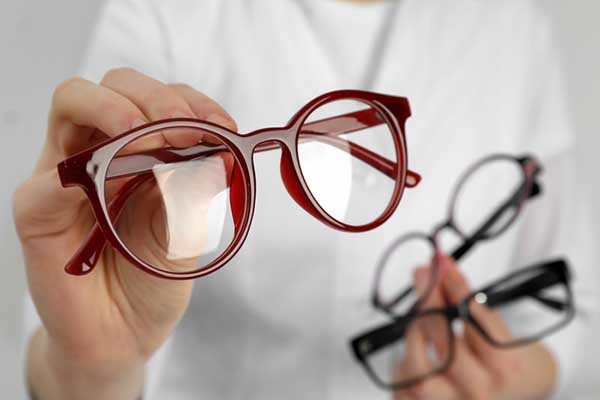
I ask about job pain. Do you grind your teeth? Do you clench your jaw?
A big one. Tell me why that’s connected.
The joint geminal nerve innervates down the mandibular area. That’s the overactive. The trigeminal becomes overactive when you are not binocularly corrected. It’s a conflict where you get that phantom pain that happens. It’s like when you’re having a heart attack. Your arm gets numb. It’s similarly-referred pain.
I got you. That’s very interesting.
If you ask your patient. I don’t know about you, but a lot of them have been saying, “I got diagnosed with TMJ.” They feel like where did this come from? Job pain has been one of the biggest changes I’ve made in the questions that I asked.
I asked that for everybody.
Do you grind your teeth? Do you clench your teeth? It’s a big one. I wanted to add that I also page my opticians in. I page them in early because I want them to understand when I’m counseling the patient, they’re listening, too, because it’s about symptom relief. It’s not just about seeing better because you’re going to update the prescription. It’s about feeling better. When you focus on the feeling, I said, “This is a lens that is like no other. You’re going to feel better with these Neurolenses.” It’s guaranteed as Dr. Ramesh’s point.
This is a lens that is like no other. You’re going to feel better with these Neurolenses.
To clarify that point, both of you have a paging system. You would pay somebody in. Trev, in your case before you go over your assessment plan. While you’re going through your assessment plan, your optician or whoever the person you’re going to hand off to is already in the room.
The cool part about that is you can have some higher-level discussions with your optician. You can say, “Little basin. It’s exophoric.” Words that maybe the patient doesn’t completely understand, but they know you’re talking medical, and they know they’re talking about you, then you reference to the patient, “We’re going to help your eyes work better together. You’re going to feel better in your jaw, your dry eye, and your headaches.”
“It’s guaranteed I’m going to phone you back myself to ensure that these are the best classes you’ve ever had.” The patient wants the symptom relief and those glasses. It’s not a sale anymore. It becomes a fulfillment of a device that’s going to help them feel better. It’s about the feeling as opposed to just seeing. I start talking about wellness and feeling better than about seeing better.
The level of service is incredible. We’re talking about Neurolens and the value of this device or this technology in the office. This is one of the things I love talking to you guys about. The level of service that you provide beyond Neurolens in your office is so high. It’s incredible. There’s so much right there that we can take away and learn from just that, whether we’re talking about Neurolens or something else. The fact that you bring your technician or optician into the room and have that conversation with them in front of the patient, including the patient in that conversation, is amazing. I assume that creates a better buy-in from the patient because you seem way more invested in their outcome.
If they have any questions, that’s being targeted right there. There are no discrepancies between what they need and what we want to have, or the optician refuses. Everyone is on the same page.
If I could add, you’re talking about the next future visits by how you manage that patient. You can have them bought in and bind to you and the practice forever if you’re thinking like that. You think they should never dream about going elsewhere, and you have to do everything to impress them, counsel them, and customize the solution for them. You get them, and you get their eyes. You’re protecting the future of their vision, not just now but in the future.
I like that. That’s great. I want to talk about that N3 for a minute. Before we do that, any other tips or tricks and advice you’d like to share on that handoff situation? Is there anything else you would feel like we maybe didn’t cover? That was pretty deep. It’s not that we were light on that. It was good.
It’s important to when the optician now sits the patient down. Every one of our patients gets a consultation in the eyewear gallery. When the handoffs are done, let’s say they say they want their prescription. They still sit down in the eyewear gallery, and the reiteration of the doctor’s recommendations is, “Dr. Miranda has recommended Neurolens for you because of this and this.” Sometimes, price discussions take place, but they take place there in the eyewear gallery, not in the exam lane. As the doctor, I recommend the solutions and what’s possible. The optician can go from there.
Let’s talk about this bad boy right here, the N3 Neurolens latest technology and release. They officially released it. We are at Vision Expo West. There are so many people trying this thing on. I finally tried it on for myself, and I had a great experience. You guys have a little more hands-on experience with it than I do. Tell us about the technology. How is this different, or how is this an advancement from the NMD2?
I can say what I love about it. What I love about it is they’re asking. The patient goes through the process. They’re doing it. It’s very quick. It’s a little bit faster than the old model. It asks the patient, “Do you want to learn more?” It’s educating the patient while they’re doing it, and it’s asking the patient if they’d like to learn more. That opens the doors to having a conversation with a doctor, and I love that they’re educated.
There was a statistic that came out that 80% of them understand the education after going through this. There’s a very high percentage of the ones that want to know more as well. It helps us open the door. We’re busy. We’re in a multidisciplinary practice. We’re going through so many certain things. It’s nice to know that they’re saying, “We want to know more,” and we get flags. It tells us that we should have that conversation with them.
I’ve noticed that patients intuitively know this is the answer for them. It’s interesting that way. The light bulb goes on, and they say, “I need this.” They want the solution to help their symptoms. Those are the great patients because it’s going to help them. They’ve been looking for something. They know something’s not right.
They’ve gone to the chiropractor or the massage therapist. They’ve tried to figure out what is wrong, and now, finally, somebody’s saying, “I can help you with these symptoms.” To be the one who can provide those solutions is heartwarming. It’s changed the way I practice. I’m excited to help people who have these problems because they’ve been long-standing in a lot of cases.

What’s the value of the headset versus the standalone tabletop device?
What we can do is have them go in the lane. Once you’re in your exam lane, they’re getting tested at that point, and that’s the last thing that they’re doing right before you enter. That conversation can start almost immediately. I don’t know about you, but I usually look at the symptoms right off the bat. One of the first things I do is get them to read, and I put a little trial lens in front of them. I’m like, “Does that change anything?” You can see their posture change and take a breath of air. You see it right away. Now, with portability, you can do it right in the exam lane.
If I could expand on that, what trial lenses that you’re using? Is it a prism, or is there something?
It’s a prism.
You’re putting a prism based on what you found through the Neurolens. That’s a quick test.
A lot of times, yes. The Neurolens will spit out, let’s say, one basin. It’s contoured down to add 0.75. The patients going to get a total of 1.75 basin. I’ll either do a 1 or a 2. I’ll put it in front of the patient and say, “Do you notice that difference?” Right away, they notice something.
I do the same thing. I would add that it’s binocularly for all. I sit down at lunch, and it’s like, everybody gets the opportunity to get their binocular vision tested. Whether they’re symptomatic or not, you’ve got a baseline for comparisons like Optomap and OCTs for everybody. I’m a wellness-based clinic, and being able to provide that, patients appreciate that.
We’re testing your binocular vision, and this is what we’re doing. They’re being educated on that, whether they need it now or later. Maybe they become more computer users and get more symptomatic later in life as they get more progressive lenses, and that causes them to be more exophoric and need some support. It’s providing future education opportunities, and it does it for you. You don’t have to use technician time. It saves you time from the workflow perspective.
Thank you again for the segue, Trevor. You’re a pro at this. Tell me about why that education piece is at the end. I ran through this, and at the end, there’s some education and the animation with it. Why is that valuable?
It circles the dots. It lines everything up. From the testing that you’re doing, which is complex like, “What is going on here?” We’re separating the I’s and trying to get your exophoric for posture, and the patient doesn’t understand fully what’s going on. They just know things are happening in there. When they get educated on why we’re doing that, things go off in their head. They connect the dots, “I could benefit from this. There’s a solution for me for some of these symptoms that I’ve been experiencing.”
Having that done for everybody consistently, it’s not like, “This patient got it and this patient didn’t. This patient had the time for an assistant to educate them and this patient didn’t because they were busy in the eyewear gallery.” Everybody gets the opportunity if they want to be educated on it. That’s an amazing thing. They’re in control of that.
It starts the conversation, so it’s not us just always asking it. It, all of a sudden, makes them think about other things that they may not have thought to tell us.
That’s amazing. I was thinking that, too. The standardization of education is key. The visuals that they use are easy to understand, though. We’re biased. We’re optometrists, so we’re going to understand the images more easily. Simply the lines moving in or out and showing where the focal point is. Here’s your focal point, and here’s where it should be. The glasses come down. All of a sudden, your focal points are where it’s supposed to be.
It’s very easy-to-understand visuals and everybody’s going to get that education, as you said. That makes a huge difference. Other times, you run it as a pretest, and you may not remember to tell the patient about it or talk about it. You might not have the time to talk about it the way you want to talk about it. That was a cool piece. The fact that it’s all done in the headset here ties it up in a nice little bow.
If I could just add, it’s a wow effect, whether the patient needs a Neurolens solution or not. The impact of having a virtual reality testing device that’s head-mounted with a virtual assistant taking you through the process of the test and educating you afterward is pretty cool. It adds to that level in the patient’s mind that, “I’m in a high-tech medical environment here.”
A lot of people were concerned with seniors. To be honest, we have a lot of seniors in our practice, so we were able to try it on them. It was very easy. It’s simple to use. It’s good for all ages.
What’s the youngest and oldest patient that you’ve used in Neurolens on or done the test?
For this particular model, there is a limit. You can’t test under a certain age.
Let’s say the NMD2.
You can test any age. Maybe not a two-year-old.
Six maybe?
Possibly, if they can follow.
How about the oldest patient you tested?
I don’t know how old. I know I’ve had someone in their 80s.
In their 90s, it’s capability. We shouldn’t have ageism. I wrote a little article about this. Even a senior patient who’s 90 should have the opportunity to try the test. Do the test. If they can do it, there is no age limit. It’s capability, limit, and understanding. If those are compromised, maybe you shouldn’t do those tests. The opportunities exist for all patients to have it.
As an example, an 80-year-old who has strokes most often. They go see their neurologist. They have trouble with reading and have headaches afterward. They feel very dizzy when they walk. They also get motion sick. You put them on the Neurolens. Do you know who’s the happiest? It’s their children. Their children are the ones that take care of them, and they’re like, “My mom and dad are reading again.”
That’s amazing. It’s impacting lives. Generational impact. Thank you for everything. You guys have been amazing. Any final words of wisdom that you might want to share? Whether it’s Neurolens or other.
For me, this belongs in every practice. This should be part of our standard of care. If you have any questions, reach out to me or Trevor. Honestly, I truly in my heart believe that this is something that everyone should be testing for.
I echo that. There are patients in every one of our practices who could use help, but furthermore, they need help. You have the opportunity to help them. If you don’t deploy Neurolens technology. You’re missing the opportunity to help somebody and, in some ways, life-changing help. That’s what I leave you with. You have this opportunity to be successful now for everybody in the lane. Take it.
Thank you, everybody, for tuning in to Canada’s number-one optometry show. Thank you to my amazing guests. I love these guys. Check out Neurolens. I want to say thank you to Neurolens for supporting this show and for putting out amazing technology. See you guys in the next episode.
Important Links
- Dr. Trevor Miranda – LinkedIn
- Dr. Kiran Ramesh – LinkedIn
- Neurolens
About Dr. Kiran Ramesh
 Dr. Ramesh lives her life based on four main values, love, connect, inspire, and empower. She connects with patients, her team, colleagues and industry to better understand their goals, and in turn inspires and empowers all to discover opportunities, push boundaries, and understand their full potential. She operates a successful multidisciplinary clinic and supports the growth of others within the optical industry with peer to peer consulting and team building. In every area of her life her judgement and her actions are solely based on her heart.
Dr. Ramesh lives her life based on four main values, love, connect, inspire, and empower. She connects with patients, her team, colleagues and industry to better understand their goals, and in turn inspires and empowers all to discover opportunities, push boundaries, and understand their full potential. She operates a successful multidisciplinary clinic and supports the growth of others within the optical industry with peer to peer consulting and team building. In every area of her life her judgement and her actions are solely based on her heart.
Dr. Ramesh is the proud recipient of 2020 Best in Training at Transitions Academy and 2019 Canada Best Eye Care Practice of the Year. She completed her Doctor of Optometry at the University of Waterloo in 2004. She served on the board of directors for VTC (Vision Therapy Canada), is an associate member of COVD (College of Optometrists in Vision Development), clinical associate of the Optometric Extension Program, and is a member of the OAO (Ontario Association of Optometrists). She has 2 beautiful daughters, and a husband that always makes her smile.
About Dr. Trevor Miranda
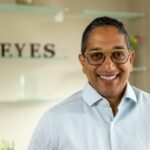 Dr. Miranda was raised in Simcoe, Ontario, and graduated from the University of Waterloo with his Doctorate of Optometry in 1995. Following graduation, he moved to beautiful Vancouver Island, where he continues to serve the eye care needs of the Cowichan Valley. Trevor is also an active member of the Third World Eye Care Society and has participated with other professionals to improve the vision of the less fortunate.
Dr. Miranda was raised in Simcoe, Ontario, and graduated from the University of Waterloo with his Doctorate of Optometry in 1995. Following graduation, he moved to beautiful Vancouver Island, where he continues to serve the eye care needs of the Cowichan Valley. Trevor is also an active member of the Third World Eye Care Society and has participated with other professionals to improve the vision of the less fortunate.
Dr. Miranda was named Optometrist of the Year by the British Columbia Association of Optometrists in March 2015. This prestigious honour recognized Dr. Miranda’s commitment to providing every patient with exceptional care while mentoring optometrists across Canada.



